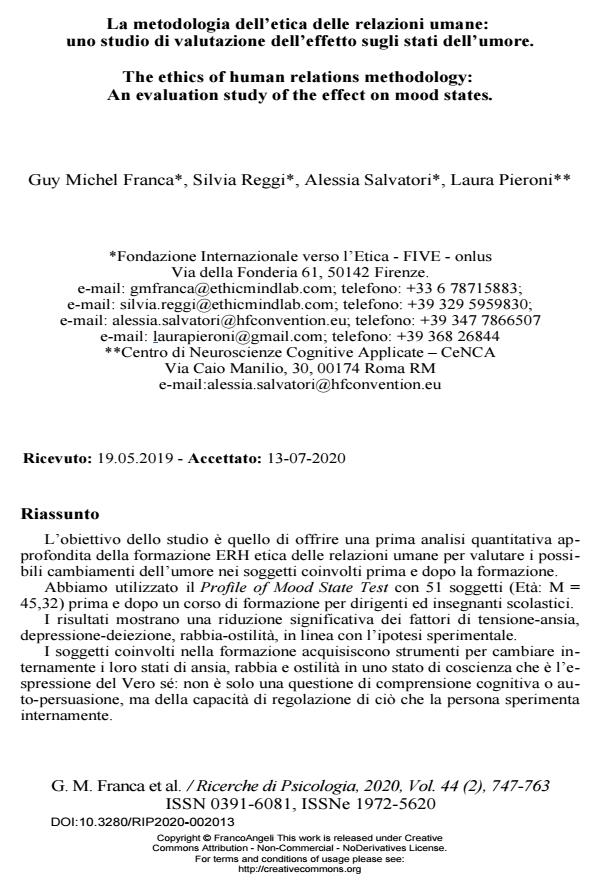The ethics of human relations methodology: An evaluation study of the effect on mood states
Journal title RICERCHE DI PSICOLOGIA
Author/s Guy Michel Franca, Silvia Reggi, Alessia Salvatori, Laura Pieroni
Publishing Year 2020 Issue 2020/2
Language Italian Pages 17 P. 747-763 File size 243 KB
DOI 10.3280/RIP2020-002013
DOI is like a bar code for intellectual property: to have more infomation
click here

FrancoAngeli is member of Publishers International Linking Association, Inc (PILA), a not-for-profit association which run the CrossRef service enabling links to and from online scholarly content.
The aim of the study is to offer a first quantitative in-depth analysis of the ERH ethics of human relationships training to evaluate the possible mood changes in the subjects involved before and after training. We have used the Pro-file of Mood State Test with 51 subjects (Age: M=45,32; St. Dev. 8,7) before and after a training course for headmasters and teachers of schools. Results show a significant reduction of Tension-Anxiety, Depression-Dejection, Anger-Hostility factors, in line with the experimental hypothesis. The subjects involved in the training acquired tools for changing internally their states of anxiety, anger and hostility in a state of conscience which is the expression of the true self: it’s not only a matter of cognitive comprehension or self-persuasion, but of the capacity of regulation of what the person internally experiences. In our hypothesis, this process takes place through the activation of the Global Neuronal Workspace (GNW). The activation of GNW allows the global availability of information coming from the sensory centers concurrently with information from the limbic system and makes them accessible to conscious-ness, thanks to the activation of diffuse long axon neurons, that are particularly present in the prefrontal and parietal areas.Thanks to this process the individual is able not only to perceive but also to elaborate and consciously integrate what he has internally experienced.
Keywords: Emotions, mood, anxiety, happiness.
- Changeux, J.P. (2008). Du vrai, du beau, du bien: Une nouvelle approche neuronal. Paris: Odile Jacob.
- Ciucci, E., Facci, C., Baroncelli, A. (2020). Preliminary evidence of efficacy of the Ethics of Human Relations approach on teachers’emotional competence. Journal of Education for Teaching. DOI: 10.1080/02607476.2020.1770581
- Damasio, A. (2010). Self Comes to Mind: Constructing the Conscious Brain. New York, Pantheon Books.
- Damasio, A. R., Tranel, D., Damasio, H. (1991). Somatic markers and the guidance of behaviour: theory and preliminary testing. In Levin, H.S., Eisenberg, H.M., Benton, A.L., a cura di, Frontal Lobe Function and Dysfunction. New York, Oxford University Press, pp. 217-229.
- Davidson, R.J. (2002) Anxiety and affective style: role of prefrontal cortex and amygdala. Biol Psychiatry, 51 :68-80
- Davidson, R.J. e Bagley S. (2012). The Emotional Life of Your Brain: How Its Unique Patterns Affect the Way You Think, Feel, and Live and How You Can Change Them. Usa: Hudson Street Press.
- Davidson, R.J., Mc Ewen B.S. (2012). Social influences on neuroplasticity: stress and interventions to promote well-being. Nature neuroscience, 15: 689-695.
- Dehaene, S., Kerszberg, M., & Changeux, J. P. (1998). A neuronal model of a global workspace in effortful cognitive tasks. Proceedings of the National Academy of Sciences of the United States of America, 95 (24): 14529-14534.
- Farnè, M. e Sebellico A. (1986). Emotional reactions in stress conditions: The effects of boredom and mental overload. Bollettino della Società Italiana di Biologia Sperimentale, 62(4), 553-559.
- Farnè, M. e Sebellico, A e Corallo, A. (1989). Effetti immediati del training autogeno. Bollettino della Società Italiana di Biologia Sperimentale, 65, 679-683.
- Farnè, M. e Sebellico, A. (1989). Ansia da esami: suoi vari aspetti. Bollettino della Società Italiana di Biologia Sperimentale, 55, 571-573.
- Franca G.M. (2014). Oltre i confini del pensiero. Fondamenti di Etica delle Relazioni Umane. Roma, Edizioni Universitarie Romane.
- Hayes, D. J. e Greenshaw, A. J. (2011). 5-HT receptors and reward-related behaviour: A review. Neuroscience & Biobehavioral Reviews, 35(6), 1419-1449.
- Klimecki, O.M., Leiberg, S., Ricard, M., Singer, T. (2014). Differential pattern of functional brain plasticity after compassion and empathy training. Social cognitive and affective neuroscience,9(6), 873-9.
- Leiberg, S, Klimecki, O, Singer, T (2011) Short-Term Compassion Training Increases Prosocial Behavior in a Newly Developed Prosocial Game. PLoS ONE, 6(3), e17798.
- Lieberman, M.D., Eisenberger, N.I., Crockett, M.J., Tom S.M., Pfeifer, JH.., Way B.M. (2007). Putting feelings into words: affect labeling disrupts amygdala activity in response to affective stimuli. Psychol Sci, 18(5): 421-428.
- Lutz, A., Slagter, H. A., Dunne, J. D., & Davidson, R. J. (2008). Attention regulation and monitoring in meditation. Trends in cognitive sciences, 12§(4) 163-169.
- McNair, D.M., Lorr, M. e Droppleman, L.F. (1981). Manual for the Profile of the Mood States. San Diego: EdITS Educational and Industrial Testing Service.
- Scherer, KR, Schorr, A, Johnstone, T. (2001). Appraisal processes in emotion: theory, methods, and research. Canary, NC, Oxford University Press.
- Siegel, D. (2014). Il terapeuta consapevole. Guida per il terapeuta alla Mindsight e all’integrazione neurale. ISC Editore.
- Thompson, W. F., Schellenberg, E. G., & Husain, G. (2001). Arousal, mood, and the Mozart effect. Psychological Science, 12(3), 248-251. DOI: 10.1111/1467-9280.00345
- Volkow, N.D., Wang, G.J., Baler, R. D. (2011). Reward dopamine and the control of food intake: implications for obesity. Trends in Cognitive Sciences, 15(1), 37-46.
- Watson, D., & Tellegen, A. (1985). Toward a consensual structure of mood. Psychological Bulletin, Vol. 98, 2: 219-235. DOI: 10.1037/0033-2909.98.2.219
- Winnicott, D.W. (1960) Ego Distortion in Terms of True and False Self. In Winnicott, D.W., a cura di, The Maturational Processes and the Facilitating Environment: Studies in the Theory of Emotional Development. London, Karnac Books, pp. 140-152.
Guy Michel Franca, Silvia Reggi, Alessia Salvatori, Laura Pieroni, La metodologia dell’etica delle relazioni umane: uno studio di valutazione dell’effetto sugli stati dell’umore in "RICERCHE DI PSICOLOGIA " 2/2020, pp 747-763, DOI: 10.3280/RIP2020-002013